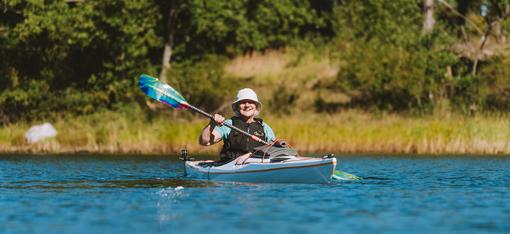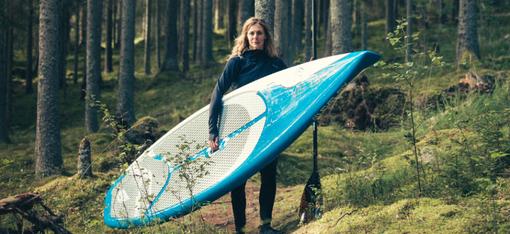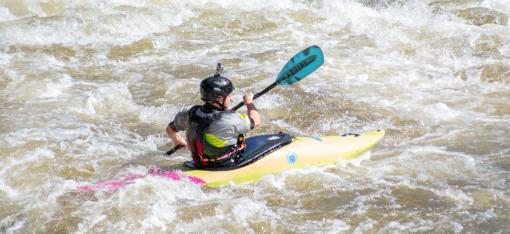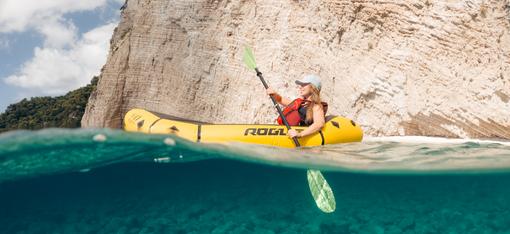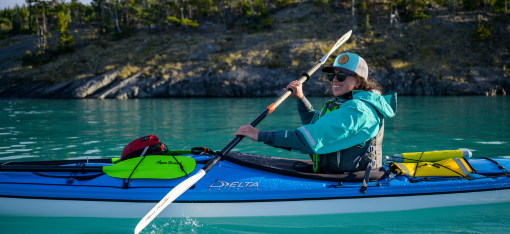Is Kayaking an Easy Entry-Level Activity for Kids?
5-minute read
Yes! Kayaking is one of the easiest entry-level activities for kids. Children as young as four or five can kayak in some conditions with no experience.

(Photo courtesy of Jason Eccles)
Put children in kayaks appropriate for their size in a calm water environment and you’ll be amazed how quickly they’ll paddle around without a problem.
Of all the paddlesports, kayaking is the easiest for beginners of all ages to learn. This is especially true for children, who love the “grown-up” feeling of being able to do something by themselves.
Even without instruction, many children can figure out how to get where they want to go in a kayak. With a little practice, they can become proficient remarkably quickly.
Why Kayaking is Easy for Kids to Learn
There are a few reasons why kayaking is very easy for most children to learn.
First, kayakers sit in the center of the boat. That center seat means there’s about as much boat in front of the paddler as behind. This makes maneuvering easier than in a canoe, which is steered from the stern or back.
Kayaks also sit low on the water and have a low profile, especially compared with canoes. So the wind isn’t able to push a kayak around like it does a boat that’s higher on the water. In turn, this means average winds won’t impede the progress of a young paddler.
Another reason kayaking is easy to learn is the paddle design. Kayak paddles have two blades instead of one, so one blade is always in the water. This adds to the ease of steering and moving, even for inexperienced paddlers.
Recreational kayaking doesn’t require strength, athletic ability or even much coordination. It doesn’t require good balance, like paddleboarding, or special steering strokes, like canoeing. Almost all children can have success right away, which makes kayaking fun—a big deal for kids.
Children naturally love to try new things and usually have more confidence than adults who learn later in life. A great time to let them have a go at kayaking is when they ask for it.

(Photo courtesy of Headwaters Kayak)
Have Kid-Size Gear
Kids will have the best early kayaking experiences when they can use gear that’s appropriate for their size.
First of all, a kid-sized PFD (life jacket or life vest) is essential. A PFD that’s too large will do no good. Any Coast Guard-approved model that fits the weight range of your child will work. One that’s comfortable will be less annoying.
All US states have life vest laws for paddlers. Check the state, province or country laws where you live. Part of the law will tell you the age below which all children must wear a PFD, not just have it in the boat.
Next, short and wide recreational kayaks are very stable and maneuverable for small paddlers. It doesn’t really matter whether the kayak is a sit-in or sit-on model. Kids can learn to enter and exit with ease either way.
For children who want to kayak but aren’t ready for their own boat, a tandem is a wonderful option. Kids can easily learn to paddle in the bow seat while an older child or adult paddles from the stern.
Finally, a kid-sized paddle makes learning the easiest, especially for young and small children. An adjustable-length paddle like ours with the Versa-Lok® ferrule system fits older children and can grow along with them.

(Photo courtesy of H2GO Paddle)
Paddle length depends on the width of the boat and the height of the paddler, no matter the age. Generally, paddles for children could be as short as 190 cm and go up from there, with adult paddles starting at about 200 cm.
That said, many children will have no problem using an adult paddle if they simply want to tool around the lake for a little while. The lighter the paddle is, the better they’ll be able to handle one that’s a little long for them.
Start in Easy Conditions
Children will usually have the most fun and success when their first kayaking experiences are in easy conditions. By this, we mean:
- A calm, warm day…
- On a small lake with easy access
The family cabin or a local public beach are great options. When you paddle your own kayak next to your child, both of you will enjoy your kayaking adventure.
Children will more likely be excited to learn to kayak if they’re already comfortable around water. Learning to swim at an early age is a definite bonus. Then kayaking is just one more fun thing they can learn to do in that environment.
Of course, like with any activity, some kids will grow tired and be ready for a change quite soon, while others may want to stay on the water in this fun boat all day long. Let them go at their own pace so these first experiences spark great memories, not bad ones.
Kayaking is a Lifetime Activity
Unlike many sports, kids can enjoy kayaking and get proficient at it without athletic ability or a ton of strength. And even if they only get on the water occasionally, it’s still accessible for all ages without needing a high level of skill to enjoy it.

Even if they’re too young to paddle, they’re not too young to catch a ride (photo courtesy of Conservation Kayak)
Best of all, they can continue to kayak throughout their lives. It’s fun, it’s healthy (although they don’t need to know that yet!) and it’s a welcome change from all those hours in front of screens.
Get kids in kayaks today, and we hope they’ll stay in kayaks for decades to come.
What paddling questions can our friendly Customer Service team help you with? Contact us at 715-755-3405 or sales@aquabound.com
More for you...

